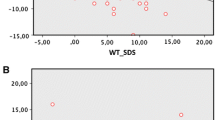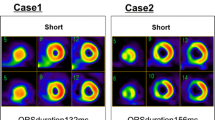Abstract
We assessedTakotsubo (ampulla) cardiomyopathy compared with acute coronary syndrome (ACS) using two-dimensional echocardiography and99mTc-tetrofosmin myocardial SPECT.Methods: We examined 10 patients withTakotsubo cardiomyopathy and 16 with ACS at the time of emergency admission (acute phase), at three to nine days after the attack (subacute phase) and at one month after the attack (chronic phase). The left ventricle was divided into nine regions on echocardiograms and SPECT images, and the degree of abnormalities in each region was scored in five grades from normal (0) to severely abnormal (4).Results: Coronary angiography revealed total or subtotal occlusion in patients with ACS but no stenotic legions in those withTakotsubo cardiomyopathy. The amount of ST segment elevation (mm) was 7.9±3.4 in patients withTakotsubo cardiomyopathy and 7.3±3.7 in those with ACS (N.S.). Abnormal wall motion scores on echocardiograms were 13.8±4.4, 4.4±3.8 and 1.8±2.3 during the acute, subacute and chronic phases in patients withTakotsubo cardiomyopathy and 13.9±4.0, 11.7±3.7, 7.6±4.2, respectively in patients with ACS. The value of MB fraction of creatine phosphokinase (IU/l) was 34±23 in patients withTakotsubo cardiomyopathy and 326±98 in those with ACS (p<0.001). Abnormal myocardial perfusion scores on99mTc-tetrofosmin myocardial SPECT were 11.4±3.2, 3.2±3.3 and 0.7±1.1 during the acute, subacute and chronic phases respectively, in patients withTakotsubo cardiomyopathy, and 15.8±4.1, 13.5±4.4, 8.2±4.4, respectively, in those with ACS. The numbers of myocardial segments that did not uptake99mTc-tetrofosmin during the acute phase were 0.5±0.8 and 3.6±2.8 in patients withTakotsubo cardiomyopathy and ACS, respectively.Conclusion: Impaired coronary microcirculation might be a causative mechanism ofTakotsubo cardiomyopathy.
Similar content being viewed by others
References
Kawai S, Suzuki H, Yamaguchi H, Tanaka K, Sawada H, Aizawa T, et al. Ampulla cardiomyopathy (Takotsubo cardiomyopathy)—Reversible left ventricular dysfunction with ST segment elevation—Jpn Circ J 2000; 64: 156–159.
Nyui N, Yamanaka O, Nakamura R, Sawano M, Kawai S. ‘Tako-tsubo’ transient ventricular dysfunction—A case report—.Jpn Circ J 2000; 64: 715–719.
Tsuchihashi K, Ueshima K, Uchida T, Oh-mura N, Kimura K, Owa M, et al. Transient left ventricular apical ballooning without coronary artery stenosis: A novel heart syndrome mimicking acute myocardial infarction.J Am Coll Cardiol 2001; 38: 11–18.
Dote K, Sato H, Tateishi H, Uchida T, Ishihara M. Myocardial stunning due to simultaneous multivessel coronary spasms: a review of 5 cases.J Cardiol 1991; 21: 203–214.
Iga K, Hori K, Kitaguchi K, Matsumura T, Gen H, Tomonaga G, et al. Transient segmental asynergy of the left ventricle of patients with various clinical manifestations possibly unrelated to the coronary artery disease.Jpn Circ J 1991; 55: 1061–1067.
Tamaki N, Takahashi N, Kawamoto M, Torizuka T, Tadamura E, Yonekura Y, et al. Myocardial tomography using technetium-99m-tetrofosmin to evaluate coronary artery disease.J Nucl Med 1994; 35: 594–600.
Veretto T, Cantalupi D, Altieri A, Orlamdi C. Emergency room technetium-99m-sestamibi imaging to rule out acute myocardial ischemic events in patients with nondiagnostic electrocardiogram.J Am Coll CArdiol 1993; 22: 1804–1808.
Braunwald E, Kloner RA. The stunned myocardium: prolonged, postischemic ventricular dysfunction.Circulation 1982; 66: 1146–1149.
Kono T, Morita H, Kuroiwa T, Onaka H, Takatsuka H, Fujiwara A. Left ventricular wall motion abnormalities in patients with subarachnoid hemorrhage: neurogenic stunned myocardium.J Am Coll Cardiol 1994; 24: 636–640.
Sakamoto H, Nishimura H, Imataka K, Ieki K, Horie T, Fuji J. Abnormal Q wave, St-segment elevation, T wave inversion and widespread focal myocytolysis associated with subarachnoid hemorrhage.Jpn Circ J 1996; 60: 254–257.
Ohtsuka T, Hamada M, Kodama K, Sasaki O, Suzuki M, Hara Y, et al. Neurogenic stunned myocardium.Circulation 2000; 101: 2122–2124.
Shaw TRD, Bafferty P, Tait GW. Transient shock and myocardial impairment caused by pheochromocytoma.Br Heart J 1987; 57: 194–198.
Salathe M, Weiss P, Ritz R. Rapid reversible of heart failure in a patient with phaeochromocytoma and catecholamine-induced cardiomyopathy who was treated with captopril.Br Heart J 1992; 68: 527–528.
Iga K, Himura Y, Izumi C, Miyamoto T, Kijima K, Gen H, et al. Reversible left ventricular dysfunction associated with Guillain-Barré syndrome: An expression of catecholamine cardiotoxicity?.Jpn Circ J 1995; 59: 236–240.
Kemp HG. Left ventricular function in patients with the anginal syndrome and normal coronary arteriograms.Am J Cardiol 1973; 32: 375–376.
Cannon RO, Epstein SE. Microvascular angina as a cause of chest pain with angiographically normal coronary arteries.Am J Cardiol 1988; 61: 1338–1343.
Sherf L, Ben-Shaul Y, Lieberman Y, Neufeld HN. The human coronary circulation: An electron microscopic study.Am J Cardiol 1977; 39: 599–607.
Guzman SV, Swenson E, Jones M. Intracoronary reflex. Demonstration by coronary angiography.Circ Res 1962; 10: 739–745.
Hori M, Inoue M, Kitakaze M, Koresune Y, Iwai K, Tamai J, et al. Role of adenosine in hyperemic response of coronary blood flow in microembolization.Am J Physiol 1986; 250: H509–518.
Hori M, Tamai J, Kitakaze M, Iwakura K, Rotoh K, Iwai K, et al. Adenosine-induced hyperemia attenuates myocardial ischemia in coronary microembolization in dogs.Am J Physiol 1989; 257: H244–251.
Nagai H, Nakamura Y, Tanaka S, Kobayashi K. Angina pectoris associated with ST segment elevation in the absence of epicardial coronary arterial obstruction.Angiology 1994; 45: 391–397.
Serota H, Kern MJ, Deligonul U, Aguirre F, Caralis DG. Ergonovine-induced myocardial ischemia without epicardial coronary vasospasm: evidence for ischemia produced by small-vessel vasoconstriction.Am Heart J 1991; 121: 1807–1809.
Mohri M, Koyanagi M, Egashira K, et al. Angina pectoris caused by coronary microvascular spasm.Lancet 1998; 351: 1165–1169.
Berne RM. Coronary circulation. InHandbook of Physiology. Vol. I The heart ed. by Berne RM et al., Bethesda; American Physiological Society, 1979: 873.
Hirsch EF, Broghard-Erdle AM. The innervation of the human heart. I. The coronary arteries and the myocardium.Arch Pathol 1961; 71: 384–407.
Johansson G, Jonesson L, Lannek N, Blomgren L, Lindberg P, Poupa O. Severe stress-cardiopathy in pigs.Am Heart J 1987; 87: 451–457.
Leor J, Poole WK, Kloner RA Sudden cardiac death triggered by an earthquake.N Engl J Med 1996; 334: 413–419.
Frustaci Q, Loperfido F, Gentiloni N, Caldarulo M, Morgante E, Russo MA. Catecholamine-induced cardiomyopathy in multiple endocrine neoplasia: A histologic, ultrastructural, and biochemical study.Chest 1991; 99: 382–385.
Yamabe H, Hanaoka J, Funakoshi T, Iwahashi M, Takeuchi M, Saito K, et al. Deep negative T waves and abnormal cardiac sympathetic image (123I-MIBG) after the great Hanshin earthquake of 1995.Am J Med Sci 1996; 311: 221–224.
Cebelin MS, Hirsch CS. Human stress cardiomyopathy: Myocardial lesions in victims of homicidal assaults without internal injuries.Hum Path 1980; 11: 123–132.
Ueyama T, Kasamutsu K, Hano T, Yamamoto K, Tsuruo Y, Nishino I. Emotional stress induced transient left ventricular hypocontraction in the rat via activation of cardiac adrenoceptors—A possible animal model ofTako-tsubo cardiomyopathy.Jpn Circ J 2002; 66: 712–713.
Murphree SS, Saffitz JE. Quantitative autoradiograpic delineation of the distribution of beta-adrenergic receptors in canine and feline left ventricular myocardium.Cir Res 1987; 60: 568–579.
Author information
Authors and Affiliations
Corresponding author
Rights and permissions
About this article
Cite this article
Ito, K., Sugihara, H., Katoh, S. et al. Assessment ofTakotsubo (ampulla) cardiomyopathy using99mTc-tetrofosmin myocardial SPECT —Comparison with acute coronary syndrome—. Ann Nucl Med 17, 115–122 (2003). https://doi.org/10.1007/BF02988449
Received:
Accepted:
Issue Date:
DOI: https://doi.org/10.1007/BF02988449




